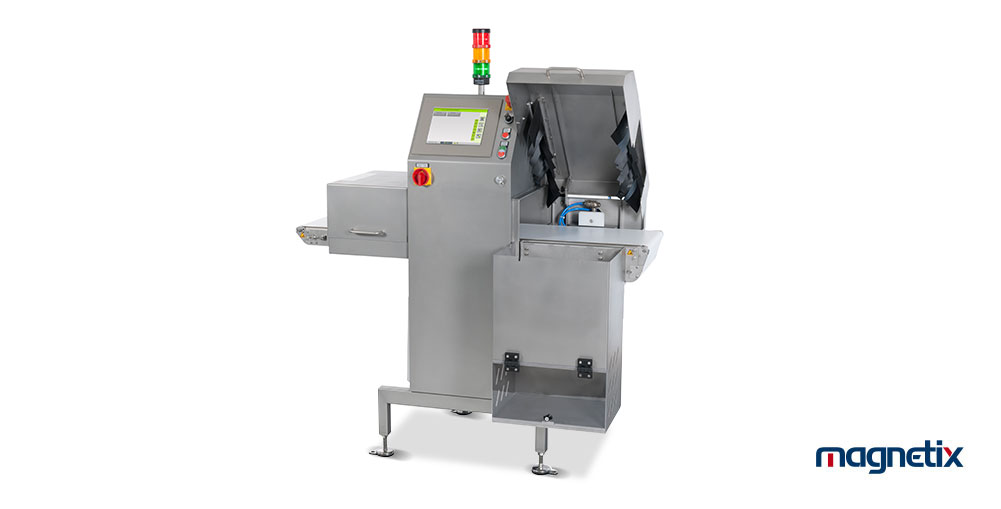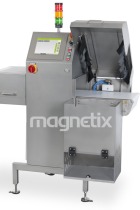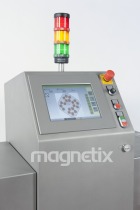Products
X-ray detector DMX

The DMX type X-ray detection system is designed to detect foreign bodies in food products with the highest sensitivity. The X-ray system detects metal contaminants, bone pieces, glass, ceramics, stones and high-density plastics. It also detects product defects, such as cracks or crumbling of the product, too much or too little filling level of the packaging, or empty spaces. At the same time, the DMX detector can mask signals coming from the type of packaging, e.g. metal clips. The product can be tested loose or in any type of packaging.
The DMX type X-ray detector is reliable, easy to use and designed for continuous operation. The DMX detector is characterized by the highest sensitivity of foreign body detection and hygienic design. The X-ray detector meets the requirements of food quality management systems ISO 9001, ISO 22000, HACCP, BRC, IFS.
Features of x-ray detectors from Magnetix
- Robust and durable design for continuous operation 24/7 under difficult working conditions.
- High detection sensitivity of foreign bodies and product defects.
- High resolution detector - accuracy max. Ø 0.3 mm.
- X-ray tube with a voltage of 100 kV and a power of 200 W.
- High level of safety for the user and the tested product.
- High durability of X-ray lamps and photodiodes.
- Industrial computer with 10- or 15-inch colour touch screen.
- Air conditioner for cooling the computer.
- 100 kV protective curtains with a lead equivalent of 0.5 mm.
- Hygienic design with materials approved for contact with food (FDA approved).
- Optical and acoustic signal system.
- Intuitive operation using a colour touch screen.
- X-ray signal monitoring.
- Automatic product learning and sensitivity adjustment to the highest possible level.
- Tuning the sensitivity by selecting a specific area in the X-ray image.
- Masking function, e.g. for packaging that causes more interference.
- Memory storage for 500 different products and 150 users.
- Login via user profiles saved on a USB stick.
- Enthernet communication interface (TCP/IP 100 Mbit/s) with the possibility of remote support by the service.
Applications of x-ray detection systems
- Cold cuts and meat products.
- Cheeses and other milk products.
- Frozen vegetables, fruits and ready meals.
- Cookies, candies, chocolate, ice cream and other confectionery.
- Rolls, bread and other bakery products.
- Loose food products packed in plastic bags and cartons.
- Dietary supplements and nutrients for athletes.
- Articles intended for personal hygiene.
- Pharmaceuticals.
The X-ray detection system allows you to inspect products in any type of packaging - cardboard, plastic packaging, vacuum packaging, glass container, metal can, metallized foil, Tetra Pak, aluminum tray. The device is widely used in the food industry, provides the highest sensitivity of detection of metal contaminants and foreign bodies and guarantees food safety.
Versions of X-ray detection systems
- DMX-FOOD
Standard version for packaged food products;
IP 66 protection class. - DMX-BULK
Specially sealed version for bulk materials;
Integrated hopper with a vibrating chute for even distribution of material over the entire width of the conveyor belt;
IP 66 protection class. - DMX-HYGIENIC
Hygienic and easy to clean, with no dead spaces where the product could accumulate;
Surface roughness < Ra 0.8 µm;
High protection class - IP 69.

Working principle of the X-ray detector
The tested product is fed into the device chamber using the "C" belt conveyor at a constant speed. The X-ray radiation emitted by the "A" lamp is limited to a beam "B" with a width of several millimeters using the collimator - two parallel plates. The radiation beam passes through the tested product and is then directed to the "D" detector consisting of X-ray photodiodes that record the received radiation. The tested product absorbs a certain part of the radiation, therefore lower intensity radiation reaches the "D" detector. The degree of radiation absorption depends on the height of the product, its density and composition. Signals from the detector "D" are converted into a digital X-ray image by the industrial computer "E". The obtained X-ray image is checked for dark spots (higher density foreign bodies) and deviations (position, shape, etc.) from the reference image using special software and appropriate algorithms.

A pneumatic rejecter is used to separate defective products. Other systems for separating or marking defective product are available on request. The X-ray detector is equipped with numerous test programs to ensure its reliable operation. X-ray images of questionable products are saved in the detector's memory.
The X-ray detection system detects metal contaminants, bone pieces, glass, ceramics, stones and high-density plastics. Product defects are also detected, such as cracks or crumbling of the product, too high or too low filling level of the packaging, or empty spaces. At the same time, the device can mask signals coming from the type of packaging, e.g. metal clips. The product can be tested loose or in any type of packaging.
Why choose our X-ray metal detectors?
The DMX X-ray detector is a device that not only detects metals, but also pieces of bones, glass, ceramics, stones as well as some types of plastics, e.g. PVC and rubber. The detector also detects product defects, such as deficiencies, damage or deformations. Thanks to this, the consumer will receive a final product of the highest quality. Due to its compact design, it can be easily installed even in an existing production line, where it can be the last control - CCP (Critical Control Point). The detector is characterized by a hygienic design - stainless steel construction, adapted for use in the food industry. The device has been designed for easy and quick cleaning and disinfection. The design protects the operator against X-ray radiation. This ensures time savings and comprehensive safe operation, without the need for mandatory documentation of working times.
Software with automatic learning function ensures simple and intuitive operation. The device automatically sets appropriate algorithms and filters to quickly introduce a new product. This function facilitates working conditions and saves the operator's time, who no longer needs to have specialized knowledge and training. The software allows you to control different products (max. 20) from different production lines. The detector recognizes which product passes through the X-ray beam in any order and independently selects the appropriate set of parameters. This allows for savings related to the purchase of only one detector instead of several and the lack of the need for prior sorting and changing product batches in the control unit. An additional benefit is the detection zone analyzer, which allows you to define zones in the X-ray image for which you can separately count and weigh the product. The obtained sensitivities are consistent with the guidelines in food directives and are even better than those required by IFS. The device is equipped with a complete log that allows you to identify settings and events, which provides solid arguments during internal and external audits. The detector can be operated on-site or remotely, ensuring short downtime in the event of technical problems.
X-ray detector price and delivery time
Based on the working conditions specified by the Customer, the appropriate type of detector is selected and its price is determined, which depends primarily on the size of the transport tunnel, the type of X-ray tube used and the industrial computer. Mounting accessories are priced individually based on an analysis of the specific location of the device.
The delivery time of the device on order is standardly 8 - 12 weeks. We also fulfill orders with an accelerated deadline. Magnetix also has a large warehouse of detectors available immediately.








